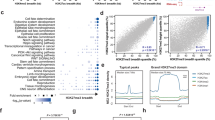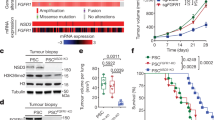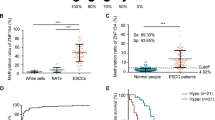Abstract
Earlier, mapping of the 9p23–24 amplicon in esophageal cancer cell lines led us to the positional cloning of gene amplified in squamous cell carcinoma 1 (GASC1), which encodes a nuclear protein with a Jumonji C domain that catalyzes lysine (K) demethylation of histones. However, the transforming roles of GASC1 in breast cancer remain to be determined. In this study, we identified GASC1 as one of the amplified genes for the 9p23–24 region in breast cancer, particularly in basal-like subtypes. The levels of GASC1 transcript expression were significantly higher in aggressive, basal-like breast cancers compared with nonbasal-like breast cancers. Our in vitro assays demonstrated that GASC1 induces transformed phenotypes, including growth factor-independent proliferation, anchorage-independent growth, altered morphogenesis in Matrigel, and mammosphere forming ability, when overexpressed in immortalized, nontransformed mammary epithelial MCF10A cells. Additionally, GASC1 demethylase activity regulates the expression of genes critical for stem cell self-renewal, including NOTCH1, and may be linked to the stem cell phenotypes in breast cancer. Thus, GASC1 is a driving oncogene in the 9p23–24 amplicon in human breast cancer and targeted inhibition of GASC1 histone demethylase in cancer could provide potential new avenues for therapeutic development.
This is a preview of subscription content, access via your institution
Access options
Subscribe to this journal
Receive 50 print issues and online access
$259.00 per year
only $5.18 per issue
Buy this article
- Purchase on Springer Link
- Instant access to full article PDF
Prices may be subject to local taxes which are calculated during checkout






Similar content being viewed by others
References
Bannister AJ, Schneider R, Myers FA, Thorne AW, Crane-Robinson C, Kouzarides T . (2005). Spatial distribution of di- and tri-methyl lysine 36 of histone H3 at active genes. J Biol Chem 280: 17732–17736.
Ben-Porath I, Thomson MW, Carey VJ, Ge R, Bell GW, Regev A et al. (2008). An embryonic stem cell-like gene expression signature in poorly differentiated aggressive human tumors. Nat Genet 40: 499–507.
Cloos PA, Christensen J, Agger K, Maiolica A, Rappsilber J, Antal T et al. (2006). The putative oncogene GASC1 demethylates tri- and dimethylated lysine 9 on histone H3. Nature 442: 307–311.
Debnath J, Muthuswamy SK, Brugge JS . (2003). Morphogenesis and oncogenesis of MCF-10A mammary epithelial acini grown in three-dimensional basement membrane cultures. Methods 30: 256–268.
Dontu G, Jackson KW, McNicholas E, Kawamura MJ, Abdallah WM, Wicha MS . (2004). Role of Notch signaling in cell-fate determination of human mammary stem/progenitor cells. Breast Cancer Res 6: R605–R615.
Esteller M . (2007). Cancer epigenomics: DNA methylomes and histone-modification maps. Nat Rev Genet 8: 286–298.
Farnie G, Clarke RB . (2007). Mammary stem cells and breast cancer—role of Notch signalling. Stem Cell Rev 3: 169–175.
Forozan F, Veldman R, Ammerman CA, Parsa NZ, Kallioniemi A, Kallioniemi OP et al. (1999). Molecular cytogenetic analysis of 11 new breast cancer cell lines. Br J Cancer 81: 1328–1334.
Geli J, Nord B, Frisk T, Edstrom Elder E, Ekstrom TJ, Carling T et al. (2005). Deletions and altered expression of the RIZ1 tumour suppressor gene in 1p36 in pheochromocytomas and abdominal paragangliomas. Int J Oncol 26: 1385–1391.
Han W, Jung EM, Cho J, Lee JW, Hwang KT, Yang SJ et al. (2008). DNA copy number alterations and expression of relevant genes in triple-negative breast cancer. Genes Chromosomes Cancer 47: 490–499.
Hess JL . (2004). MLL: a histone methyltransferase disrupted in leukemia. Trends Mol Med 10: 500–507.
Hu C, Dievart A, Lupien M, Calvo E, Tremblay G, Jolicoeur P . (2006). Overexpression of activated murine Notch1 and Notch3 in transgenic mice blocks mammary gland development and induces mammary tumors. Am J Pathol 168: 973–990.
Ignatoski KM, Lapointe AJ, Radany EH, Ethier SP . (1999). erbB-2 overexpression in human mammary epithelial cells confers growth factor independence. Endocrinology 140: 3615–3622.
Ignatoski KM, Maehama T, Markwart SM, Dixon JE, Livant DL, Ethier SP . (2000). ERBB-2 overexpression confers PI 3′ kinase-dependent invasion capacity on human mammary epithelial cells. Br J Cancer 82: 666–674.
Italiano A, Attias R, Aurias A, Perot G, Burel-Vandenbos F, Otto J et al. (2006). Molecular cytogenetic characterization of a metastatic lung sarcomatoid carcinoma: 9p23 neocentromere and 9p23-p24 amplification including JAK2 and JMJD2C. Cancer Genet Cytogenet 167: 122–130.
Jones PA, Baylin SB . (2007). The epigenomics of cancer. Cell 128: 683–692.
Katoh Y, Katoh M . (2007). Comparative integromics on JMJD2A, JMJD2B and JMJD2C: preferential expression of JMJD2C in undifferentiated ES cells. Int J Mol Med 20: 269–273.
Klose RJ, Kallin EM, Zhang Y . (2006). JmjC-domain-containing proteins and histone demethylation. Nat Rev Genet 7: 715–727.
Klose RJ, Zhang Y . (2007). Regulation of histone methylation by demethylimination and demethylation. Nat Rev Mol Cell Biol 8: 307–318.
Knuutila S, Bjorkqvist AM, Autio K, Tarkkanen M, Wolf M, Monni O et al. (1998). DNA copy number amplifications in human neoplasms: review of comparative genomic hybridization studies. Am J Pathol 152: 1107–1123.
Kreike B, van Kouwenhove M, Horlings H, Weigelt B, Peterse H, Bartelink H et al. (2007). Gene expression profiling and histopathological characterization of triple-negative/basal-like breast carcinomas. Breast Cancer Res 9: R65.
Krivtsov AV, Armstrong SA . (2007). MLL translocations, histone modifications and leukaemia stem-cell development. Nat Rev Cancer 7: 823–833.
Krivtsov AV, Twomey D, Feng Z, Stubbs MC, Wang Y, Faber J et al. (2006). Transformation from committed progenitor to leukaemia stem cell initiated by MLL-AF9. Nature 442: 818–822.
Lal G, Padmanabha L, Smith BJ, Nicholson RM, Howe JR, O'Dorisio MS et al. (2006). RIZ1 is epigenetically inactivated by promoter hypermethylation in thyroid carcinoma. Cancer 107: 2752–2759.
Loh YH, Zhang W, Chen X, George J, Ng HH . (2007). Jmjd1a and Jmjd2c histone H3 Lys 9 demethylases regulate self-renewal in embryonic stem cells. Genes Dev 21: 2545–2557.
Moffa AB, Tannheimer SL, Ethier SP . (2004). Transforming potential of alternatively spliced variants of fibroblast growth factor receptor 2 in human mammary epithelial cells. Mol Cancer Res 2: 643–652.
Neve RM, Chin K, Fridlyand J, Yeh J, Baehner FL, Fevr T et al. (2006). A collection of breast cancer cell lines for the study of functionally distinct cancer subtypes. Cancer Cell 10: 515–527.
Northcott PA, Nakahara Y, Wu X, Feuk L, Ellison DW, Croul S et al. (2009). Multiple recurrent genetic events converge on control of histone lysine methylation in medulloblastoma. Nat Genet 41: 465–472.
Peters AH, O'Carroll D, Scherthan H, Mechtler K, Sauer S, Schofer C et al. (2001). Loss of the Suv39 h histone methyltransferases impairs mammalian heterochromatin and genome stability. Cell 107: 323–337.
Pierga JY, Reis-Filho JS, Cleator SJ, Dexter T, Mackay A, Simpson P et al. (2007). Microarray-based comparative genomic hybridisation of breast cancer patients receiving neoadjuvant chemotherapy. Br J Cancer 96: 341–351.
Poetsch M, Dittberner T, Woenckhaus C . (2002). Frameshift mutations of RIZ, but no point mutations in RIZ1 exons in malignant melanomas with deletions in 1p36. Oncogene 21: 3038–3042.
Politi K, Feirt N, Kitajewski J . (2004). Notch in mammary gland development and breast cancer. Semin Cancer Biol 14: 341–347.
Rizzo P, Osipo C, Foreman K, Golde T, Osborne B, Miele L . (2008). Rational targeting of Notch signaling in cancer. Oncogene 27: 5124–5131.
Sansone P, Storci G, Giovannini C, Pandolfi S, Pianetti S, Taffurelli M et al. (2007). p66Shc/Notch-3 interplay controls self-renewal and hypoxia survival in human stem/progenitor cells of the mammary gland expanded in vitro as mammospheres. Stem Cells 25: 807–815.
Savelyeva L, Claas A, An H, Weber RG, Lichter P, Schwab M . (1999). Retention of polysomy at 9p23-24 during karyotypic evolution in human breast cancer cell line COLO 824. Genes Chromosomes Cancer 24: 87–93.
Savelyeva L, Claas A, Matzner I, Schlag P, Hofmann W, Scherneck S et al. (2001). Constitutional genomic instability with inversions, duplications, and amplifications in 9p23-24 in BRCA2 mutation carriers. Cancer Res 61: 5179–5185.
Sharpless NE . (2005). INK4a/ARF: a multifunctional tumor suppressor locus. Mutat Res 576: 22–38.
Shi Y, Whetstine JR . (2007). Dynamic regulation of histone lysine methylation by demethylases. Mol Cell 25: 1–14.
Steele-Perkins G, Fang W, Yang XH, Van Gele M, Carling T, Gu J et al. (2001). Tumor formation and inactivation of RIZ1, an Rb-binding member of a nuclear protein-methyltransferase superfamily. Genes Dev 15: 2250–2262.
Vinatzer U, Gollinger M, Mullauer L, Raderer M, Chott A, Streubel B . (2008). Mucosa-associated lymphoid tissue lymphoma: novel translocations including rearrangements of ODZ2, JMJD2C, and CNN3. Clin Cancer Res 14: 6426–6431.
Wang GG, Cai L, Pasillas MP, Kamps MP . (2007). NUP98-NSD1 links H3K36 methylation to Hox-A gene activation and leukaemogenesis. Nat Cell Biol 9: 804–812.
Whetstine JR, Nottke A, Lan F, Huarte M, Smolikov S, Chen Z et al. (2006). Reversal of histone lysine trimethylation by the JMJD2 family of histone demethylases. Cell 125: 467–481.
Wissmann M, Yin N, Muller JM, Greschik H, Fodor BD, Jenuwein T et al. (2007). Cooperative demethylation by JMJD2C and LSD1 promotes androgen receptor-dependent gene expression. Nat Cell Biol 9: 347–353.
Woods Ignatoski KM, Livant DL, Markwart S, Grewal NK, Ethier SP . (2003). The role of phosphatidylinositol 3′-kinase and its downstream signals in erbB-2-mediated transformation. Mol Cancer Res 1: 551–560.
Yang ZQ, Imoto I, Fukuda Y, Pimkhaokham A, Shimada Y, Imamura M et al. (2000). Identification of a novel gene, GASC1, within an amplicon at 9p23-24 frequently detected in esophageal cancer cell lines. Cancer Res 60: 4735–4739.
Yang ZQ, Imoto I, Pimkhaokham A, Shimada Y, Sasaki K, Oka M et al. (2001). A novel amplicon at 9p23–24 in squamous cell carcinoma of the esophagus that lies proximal to GASC1 and harbors NFIB. Jpn J Cancer Res 92: 423–428.
Yang ZQ, Streicher KL, Ray ME, Abrams J, Ethier SP . (2006). Multiple interacting oncogenes on the 8p11-p12 amplicon in human breast cancer. Cancer Res 66: 11632–11643.
Acknowledgements
This work was supported by a grant from the Department of Defense Breast Cancer Program (DAMD17–03–1–0459) to Zeng-Quan Yang and a grant from the National Institutes of Health (RO1 CA100724) to Stephen P Ethier.
Author information
Authors and Affiliations
Corresponding author
Additional information
Supplementary Information accompanies the paper on the Oncogene website (http://www.nature.com/onc)
Rights and permissions
About this article
Cite this article
Liu, G., Bollig-Fischer, A., Kreike, B. et al. Genomic amplification and oncogenic properties of the GASC1 histone demethylase gene in breast cancer. Oncogene 28, 4491–4500 (2009). https://doi.org/10.1038/onc.2009.297
Received:
Revised:
Accepted:
Published:
Issue Date:
DOI: https://doi.org/10.1038/onc.2009.297
Keywords
This article is cited by
-
Chromatin-modifying enzymes as modulators of nuclear size during lineage differentiation
Cell Death Discovery (2023)
-
Zinc finger myeloid Nervy DEAF-1 type (ZMYND) domain containing proteins exert molecular interactions to implicate in carcinogenesis
Discover Oncology (2022)
-
GASC1 promotes hepatocellular carcinoma progression by inhibiting the degradation of ROCK2
Cell Death & Disease (2021)
-
Histone demethylase KDM4C controls tumorigenesis of glioblastoma by epigenetically regulating p53 and c-Myc
Cell Death & Disease (2021)
-
JMJD2C promotes colorectal cancer metastasis via regulating histone methylation of MALAT1 promoter and enhancing β-catenin signaling pathway
Journal of Experimental & Clinical Cancer Research (2019)



